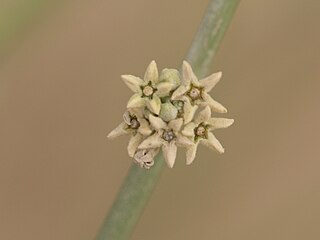
Cynanchum is a genus of about 300 species including some swallowworts, belonging to the family Apocynaceae. The taxon name comes from Greek kynos and anchein, hence the common name for several species is dog-strangling vine. Most species are non-succulent climbers or twiners. There is some evidence of toxicity.

Joseph Decaisne was a French botanist and agronomist. He became an aide-naturaliste to Adrien-Henri de Jussieu (1797-1853), who served as the chair of rural botany. It was during this time that he began to study plants brought back by various travelers like those of Victor Jacquemont (1801-1832) from Asia. Decaisne used applied research, most notably on the agronomy of the madder, the yam and the ramie. He was also interested in algae.

Secamone is a genus of plant in family Apocynaceae, first described as a genus in 1810. It is widespread across much of Africa, northern Australia, southern Asia, with numerous species endemic to Madagascar.

Cryptolepis is a plant genus in the family Apocynaceae. It includes some 42 species.

Periploca is a genus of plants in the family Apocynaceae, first described for modern science by Linnaeus in 1753. It is native to Europe, Asia, and Africa.
- Periploca aphyllaDecne. - Middle East from Sinai to Pakistan
- Periploca calophylla(Wight) Falc. - S China, Nepal, Bhutan, Assam, E Himalayas, Vietnam
- Periploca chevalieriBrowicz - Cape Verde Islands
- Periploca chrysanthaD.S. Yao, X.D. Chen & J.W. Ren - Gansu Province in China
- Periploca floribundaTsiang - Yunnan, Vietnam
- Periploca forrestiiSchltr. - Guangxi, Guizhou, Qinghai, Sichuan, Tibet, Yunnan, India, Kashmir, Myanmar, Nepal
- Periploca graecaL. - Mediterranean
- Periploca hydaspidisFalc. - Kashmir
- Periploca laevigataAiton - Canary Islands, Savage Islands
- Periploca linearifoliaQuart.-Dill. & A. Rich - Ethiopia
- Periploca nigrescensAfzel. - W Africa
- Periploca refractifoliaGilli - Tanzania
- Periploca sepiumBunge - widespread across much of China
- Periploca tsiangiiD. Fang & H.Z. Ling - Guangxi Province in China
- Periploca visciformis(Vatke) K. Schum. - Somalia

Stapelianthus is a genus of flowering plants in the family Apocynaceae, first described as a genus in 1933. The entire genus is endemic to Madagascar and is concentrated in the far south of the island.

Periplocoideae is a subfamily of the dogbane plant family, Apocynaceae. It was not divided into tribes as of 2014.

Secamonoideae is a subfamily of the dogbane family, Apocynaceae.

Decanema is a small genus in the dogbane family first described as a genus in 1838. The group is endemic to Madagascar.
- Decanema bojerianumDecne. - Madagascar
- Decanema luteifluensJum. & H.Perrier - Madagascar

Heterostemma is a genus of plants in the family Apocynaceae, first described in 1834. It is native to India, China, Taiwan, Southeast Asia, Australia, and certain islands in the Pacific.

Leptadenia is a genus of plants in the family Apocynaceae, first described as a genus in 1810. It is native to Africa, including Madagascar, as well as southwest Asia and the Indian Subcontinent.
- Leptadenia arborea(Forssk.) Schweinf. - Sudan, Ethiopia
- Leptadenia lancifolia(Schumach. & Thonn.) Decne. - tropical Africa
- Leptadenia madagascariensisDecne. - Madagascar
- Leptadenia pyrotechnica(Forssk.) Decne. - widespread from Algeria to India
- Leptadenia reticulata(Retz.) Wight & Arn. - Madagascar
Pentatropis is a genus of plants in the family Apocynaceae, first described as a genus in 1834. It is native to Africa and southern Asia.

Petopentia, commonly known as propeller vine, is a genus of plant in the family Apocynaceae first described as a genus in 1954. It contains only one known species, Petopentia natalensis, native to the Province of KwaZulu-Natal in eastern South Africa.
Ischnolepis is a species of plants in the family Apocynaceae first described as a genus in 1909. It contains only one known recognized species, Ischnolepis graminifolia, endemic to Madagascar.

Tacazzea is a genus of plants in the family Apocynaceae, first described in 1890. It is native to Africa.
Pervillaea is a genus of plants in the family Apocynaceae, first described as a genus in 1844. It is native to Mauritius and Madagascar in the Indian Ocean.
- Pervillaea brevirostrisKlack. - Mauritius
- Pervillaea decaryi(Choux) Klack. - Madagascar
- Pervillaea phillipsoniiKlack. - Madagascar
- Pervillaea tomentosaDecne. - Madagascar
- Pervillaea venenata(Baill.) Klack. - Madagascar
Calyptranthera is a genus of plants in the family Apocynaceae, first described as a genus in 1996. The entire genus is endemic to Madagascar in the Indian Ocean.
Baroniella is a genus of flowering plants belonging to the family Apocynaceae.
Camptocarpus is a genus of flowering plants belonging to the family Apocynaceae.











